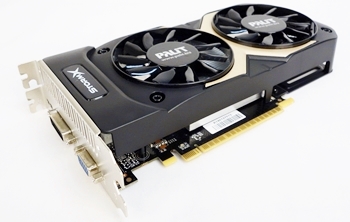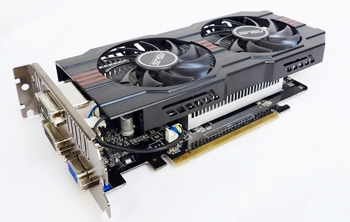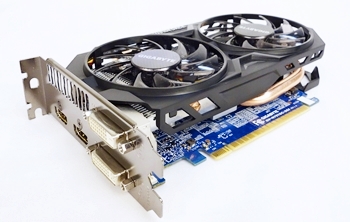NVIDIA GeForce GTX 750 Ti Custom Card Shootout
Custom GeForce GTX 750 Ti Offerings
The NVIDIA GeForce GTX 750 Ti, featuring the new first generation Maxwell graphics core, was launched last month. With this new entry, NVIDIA aims to deliver 1080p gaming (at least most of the time), with optimal performance per watt, from a bottom-up approach. To reiterate, the NVIDIA GeForce GTX 750 Ti will replace the budget Kepler-based GeForce GTX 650 Ti. Since we've established how the new GPU performs, we move on to check out what NVIDIA's partners have to offer and hopefully better what we've experienced on the reference card.
ASUS GeForce GTX 750 Ti OC 2GB GDDR5
The ASUS GeForce GTX 750 Ti OC card boasts of a slightly overclocked GM107 core. It is rated to perform with a base clock speed of 1072MHz (higher than the default of 1020MHz), and can be boosted up to 1150MHz. It boasts of VRM components with the Super Alloy Power brand name, and features a pair of dust-proof cooling fans.

The PCB of the card measures 174mm; in comparison, the reference GeForce GTX 750 Ti's one measures just 144mm. Therefore, we can assume that ASUS has used its customized PCB for the card's construct. Further to that, the reference GeForce GTX 750 Ti design does away with any power connectors, but this ASUS card has a single 6-pin Molex power connector, which we presume is to supplement its overclocked state and perhaps help it overclock better. From its rear bracket to the edge of its fan cooler, the ASUS card measures 213mm in length.

For its video connectivity options, the card has two dual-link DVI-D connectors, one HDMI port, and a D-Sub one.

Gigabyte GeForce GTX 750 Ti Windforce OC
The Gigabyte GeForce GTX 750 Ti Windforce OC card features the familiar Windforce cooling system, with its signature skeleton thin fan shroud. Its pair of 90mm PWM fans provides cooling to its overclocked GM107 core that is rated at 1033MHz, with a boost clock of 1111MHz. In addition, the card sports Gigabyte's Ultra Durable 2 VRM components.
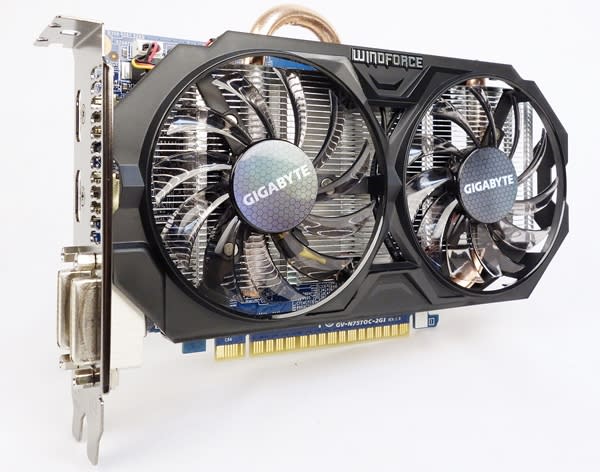

Like the reference GeForce GTX 750 Ti, the Gigabyte card has a PCB of similar length at 144mm, but the cooler unit of the card extends the overall length of the card to 188mm. We can assume that the Gigabyte's card features the same PCB as the reference GeForce GTX 750 Ti. Like the ASUS card, it too draws additional power from a 6-pin Molex PCIe connector.

The video ports consists of two dual-link DVI connectors; one DVI-D, and the other is DVI-I. On top of that, there is also a pair of HDMI ports.
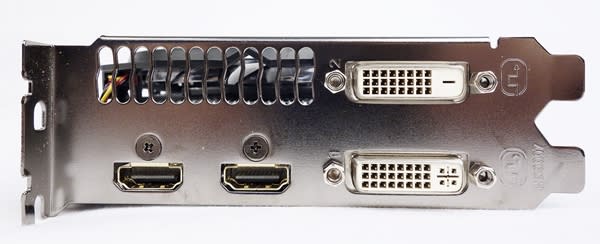
Palit GeForce GTX 750 Ti StormX Dual
Rounding up our mini comparison is the Palit GeForce GTX 750 Ti StormX Dual. The Palit card features the GM107 GPU with the highest overclock speed of 1202MHz, and a boost speed rated at 1281MHz. Also, it boasts of an improved PWM design, with quality components to boot. Interestingly, it doesn't need any additional power and hence there are no PCIe power connectors on this card.


The rear of the card reveals a PCB, also most likely of reference design, with a length of 144mm, just like the Gigabyte card. We can see the vents which allow some of the hot air to be expelled by one of the cooling fans. The card measures 217mm in length; 4mm longer than the ASUS card.
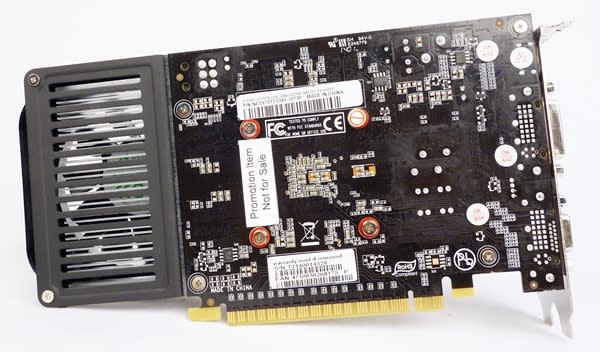
The Palit card has a mini-HDMI port, a DVI-I connector, and a D-Sub port. In comparison, the reference GeForce GTX 750 Ti card features a pair of dual-link DVI connectors, and a mini-HDMI port. Palit's configuration of outputs is the least favorable considering it's now the year 2014. However, it's the only card that has an entire expansion slot dedicated to exhausting heat from the card; we'll soon find out if that helps its temperature performance.
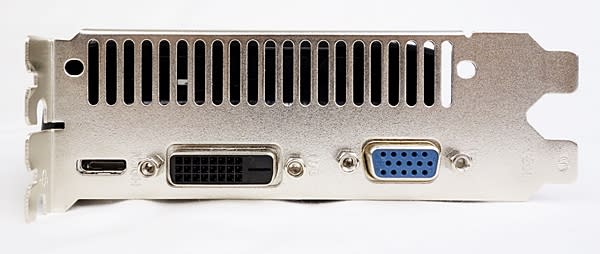
Here’s a table showing how all the tested cards measure up against other recent comparable graphics cards.
|
|
|
|
|
|
|
|
|
|
|
|
|
|
|
|
|
|
|
|
|
|
|
|
|
|
|
|
|
|
|
|
|
|
|
|
|
|
|
|
|
|
|
|
|
|
|
|
|
|
|
|
|
|
|
|
|
|
|
|
|
|
|
|
|
|
|
|
|
|
|
|
|
|
|
|
|
|
|
|
|
|
|
|
|
|
|
|
|
|
|
|
|
|
|
|
|
|
|
| — | — |
— | — | — | — |
| — |
Test Setup
These are the specifications of our graphics testbed:
Intel Core i7-3960X (3.3GHz)
ASUS P9X79 Pro (Intel X79 chipset) Motherboard
4 x 2GB DDR3-1600 G.Skill Ripjaws Memory
Seagate 7200.10 200GB SATA hard drive (OS)
Western Digital Caviar Black 7200 RPM 1TB SATA hard drive (Benchmarks + Games)
Windows 7 Ultimate 64-bit
In addition to fielding the reference GeForce GTX 750 Ti card, we also included the GeForce GTX 660 and the GeForce GTX 650 Ti cards. For the last two cards, we had to emulate their latest performances by downclocking the MSI GeForce GTX 660 Twin Frozr III OC 2GB GDDR5 and Gigabyte GTX 650 Ti 1GB GDDR5 respectively. In any case, the figures are for reference purposes to give you an idea how these competitive older generation cards compare.
ASUS GeForce GTX 750 Ti OC 2GB GDDR5 (ForceWare 334.69)
Gigabyte GeForce GTX 750 Ti Windforce OC 2GB GDDR5 (ForceWare 334.69)
Palit GeForce GTX 750 Ti StormX Dual 2GB GDDR5 (ForceWare 334.69)
NVIDIA GeForce GTX 750 Ti 2GB GDDR5 (ForceWare 334.69)
NVIDIA GeForce GTX 660 2GB GDDR5 (ForceWare 334.69)
NVIDIA GeForce GTX 650 Ti 1GB GDDR5 (ForceWare 334.69)
Note 1: In temperature and power consumption comparisons, the results for the NVIDIA GeForce GTX 650 Ti gathered from the actual reference card tested much earlier. Please refer to our reviews for the NVIDIA GeForce GTX 650 Ti. For the NVIDIA GeForce GTX 660, we don't have any results from a reference card; hence, we took both power and temperature readings from our downclocked MSI GeForce GTX 660 Twin Frozr III OC 2GB GDDR5.
Benchmarks
Here's the full list of benchmarks that we'll be using for our assessment; we would have included Crysis 3, but the technical glitch still persisted. On the other hand, we managed to put all the cards listed above through our new gaming benchmark, Call of Duty: Ghosts. Since the full performance aspects of the GeForce GTX 750 Ti have been assessed previously, we'll only be using a subset of benchmarks in this roundup article:-
Futuremark 3DMark 2013
Call of Duty: Ghosts
For our temperature and power consumption tests, 3DMark 2011 was used.
Gaming Performance
To gauge the gaming performance of the cards, we tested them with our 3DMark 2013 benchmark that consists of the Fire Strike and Fire Strike Extreme tests. Following which, we put the cards through their paces with our new game test, Call of Duty: Ghosts. It supports NVIDIA's technologies that include TXAA anti-aliasing, 3D Vision, SLI and PhysX. This new game is powered by the IW6 engine that has been updated from the one used in Call of Duty: Modern Warfare 3 game title.
From the results, we can see that the NVIDIA GeForce GTX 750 Ti custom cards clearly outclassed the previous generation GeForce GTX 650 Ti GPU that is replaces. Among the triplet, it is evident that the Palit was the winner as both its GM107 core and memory modules were overclocked by quite a fair bit. In comparison, the Gigabyte GeForce GTX 750 Ti Windforce OC brought up the rear as its memory modules weren't overclocked; while its GPU core was notched up slightly to 1033MHz, a mere 13MHz increment over the default value of 1020MHz. As for the ASUS card, its GM107 core was overclocked to 1072MHz, and its memory modules were left at their default clock speeds.
The older, more powerful GeForce GTX 660 pulled ahead against the newer GeForce GTX 750 Ti cards. For the 3DMark 2013 scores, only the heavily overclocked Palit card managed to narrow the winning margin of the GeForce GTX 660 to approximately 2.7%. In comparison, the two other cards trailed behind the GeForce GTX 660 by margins that range from 12- to 17%.
For the Call of Duty: Ghosts benchmark, we fixed the game quality settings at High, and set anti-aliasing to 4x. With such settings, Full HD gaming is definitely acceptable with the custom GTX 750 Ti cards, as the average frame rates churned out by them, at the resolution of 19200 x 1200 pixels, are above 30fps. As expected, the Palit GeForce GTX 750 Ti StormX Dual card had the best performance.

Overclocking Performance
For our overclocking exercise, we were actually hindered by the dated software utility as the maximum overclocking headspace allowed was capped at an offset of 135MHz. All the cards were able to perform stably after we increase their different base clock speeds by 135MHz. The slowest card, Gigabyte, had the most to gain from overclocking as its 3DMark 2013 scores improved by a margin in the range of 12- 13%. The ASUS card was second, with gains of around 12%, and the Palit's gain was a mere 5%. Therefore, in our opinion, it isn't worth the effort to overclock the Palit card as it's plenty fast out of the box. In fact, the overclocked results of the ASUS and Gigabyte card roughly match that of the Palit card without overclocking.

Temperature and Power Consumption
The operating temperature of the Gigabyte GeForce GTX 750 Ti Windforce OC was the lowest at 46 degrees Celsius. This observation is likely due to its modest overclocked state, as well as the efficiency of the Windforce cooling system. The price of Palit's winning performance is its high operating temperature of 55 degrees Celsius. The ASUS GeForce GTX 750 Ti walked the middle path, with its recorded temperature of 51 degrees Celsius.
The GeForce GTX 750 Ti graphics card features the NVIDIA GPU Boost 2.0 technology to boost performance by using the GPU temperature threshold, and power consumption as factors. Given the extra temperature headroom for the Gigabyte card, plus its additional power draw from its onboard 6-pin power Molex power connector, we didn't expect the card's performance to be so muted. With reference to their power consumption levels, it appears the 6-pin power connector, present on both ASUS and Gigabyte cards, didn't provide any additional performance gains through GPU Boost. The Palit card was the only one who eschewed the need for additional power draw. Even with its heavy overclocked GPU core, power consumption was recorded at a high of 234W, which isn't too far off from its peers.


Conclusion
The factory overclocked cards generally perform better, and they showed their mettle against the older and more powerful GTX GeForce GTX 660 graphics card, especially when overclocked. To make things more attractive, the new GeForce GTX 750 Ti cards are priced at around S$260. This makes it an ideal graphics card for the mainstream gamer who is upgrading from a system only with integrated graphics or building a value oriented gaming system. With Full-HD gaming possible on these cards without taxing image quality settings, the GeForce GTX 750 Ti sets a new benchmark for entry-level gaming cards from a value perspective.
To be exact, the prices of the ASUS and Gigabyte cards are just slighter higher by around S$10 than Palit's price of S$240. Given Palit's stellar performance, the card would have been an absolute steal; however, the Palit card is hindered by its video connectivity options that consist of a mini-HDMI interface, a dual-link DVI-D connector, and a D-Sub one. Therefore, a gamer looking to set up a digital multi-display setup may be hindered by its weakest link, the mini-HDMI interface and the old D-Sub connector. By far, in our opinion, the ASUS card has the best video connectivity options that include a HDMI interface that makes it easier to connect to a supported television display. The card's pair of DVI ports is suitable for a digital multi-monitor configuration. Its legacy D-Sub port for instances if you have an old, VGA monitor on hand. Gigabyte's all-digital set of outputs are also equally lucrative.

The Palit GeForce GTX 750 Ti StormX Dual is clearly the overall winner in this shootout, for its outstanding performance right out of the box. We like its clean cut appearance as it doesn't have any heatpipes protruding. Its power consumption levels and operating temperatures recorded are within expectations. If you can overlook its slight limitations in terms of its video connectivity options, this is the card to pick from the current crop of offerings.
The ASUS GeForce GTX 750 Ti OC is a strong runner-up; the card ran at a cool 51 degrees Celsius despite the absence of any heatpipes for its cooling system. Its cooling fans were actually the quietest of the lot, and its power consumption level was the lowest among the three.
The Gigabyte GeForce GTX 750 Ti Windforce OC only showed its winning form when it came to operating temperatures. This can be attributed to its modest overclocked headspace for its GM107 GPU, as well as the presence of an 8mm copper heatpipe of its Windforce cooling system. Other than that, the card had a muted run for our shootout.


